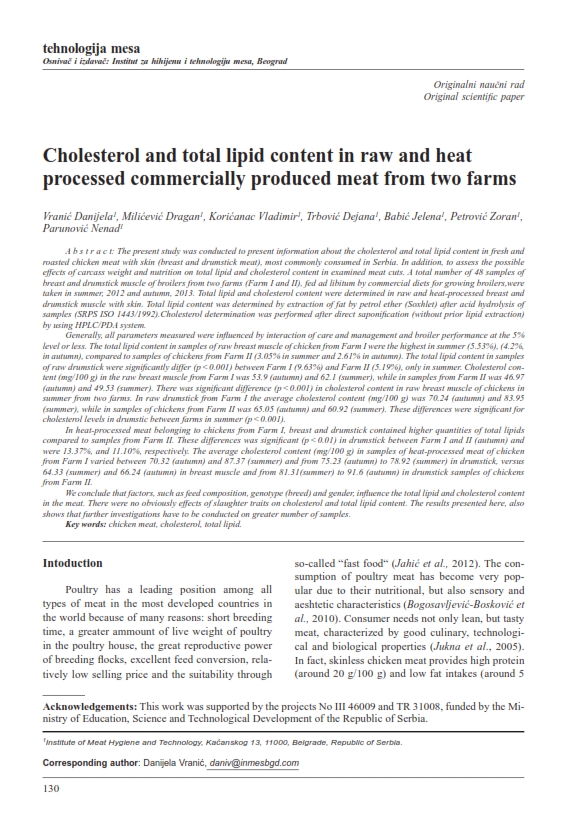Cholesterol and total lipid content in raw and heat processed commercially produced meat from two farms
Abstract
The present study was conducted to present information about the cholesterol and total lipid content in fresh and roasted chicken meat with skin (breast and drumstick meat), most commonly consumed in Serbia. In addition, to assess the possible effects of carcass weight and nutrition on total lipid and cholesterol content in examined meat cuts. A total number of 48 samples of breast and drumstick muscle of broilers from two farms (Farm I and II), fed ad libitum by commercial diets for growing broilers,were taken in summer, 2012 and autumn, 2013. Total lipid and cholesterol content were determined in raw and heat-processed breast and drumstick muscle with skin. Total lipid content was determined by extraction of fat by petrol ether (Soxhlet) after acid hydrolysis of samples (SRPS ISO 1443/1992).Cholesterol determination was performed after direct saponifi cation (without prior lipid extraction) by using HPLC/PDA system. Generally, all parameters measured were infl uenced by interaction of care and management and broiler performance at the 5% level or less. The total lipid content in samples of raw breast muscle of chicken from Farm I were the highest in summer (5.53%), (4.2%, in autumn), compared to samples of chickens from Farm II (3.05% in summer and 2.61% in autumn). The total lipid content in samples of raw drumstick were signifi cantly differ (p < 0.001) between Farm I (9.63%) and Farm II (5.19%), only in summer. Cholesterol content (mg/100 g) in the raw breast muscle from Farm I was 53.9 (autumn) and 62.1 (summer), while in samples from Farm II was 46.97 (autumn) and 49.53 (summer). There
was significant difference (p < 0.001) in cholesterol content in raw breast muscle of chickens in summer from two farms. In raw drumstick from Farm I the average cholesterol content (mg/100 g) was 70.24 (autumn) and 83.95 (summer), while in samples of chickens from Farm II was 65.05 (autumn) and 60.92 (summer). These differences were significant for cholesterol levels in drumstic between farms in summer (p < 0.001).
In heat-processed meat belonging to chickens from Farm I, breast and drumstick contained higher quantities of total lipids compared to samples from Farm II. These differences was signifi cant (p < 0.01) in drumstick between Farm I and II (autumn) and were 13.37%, and 11.10%, respectively. The average cholesterol content (mg/100 g) in samples of heat-processed meat of chicken from Farm I varied between 70.32 (autumn) and 87.37 (summer) and from 75.23 (autumn) to 78.92 (summer) in drumstick, versus 64.33 (summer) and 66.24 (autumn) in breast muscle and from 81.31(summer) to 91.6 (autumn) in drumstick samples of chickens from Farm II.
We conclude that factors, such as feed composition, genotype (breed) and gender, infl uence the total lipid and cholesterol content in the meat. There were no obviously effects of slaughter traits on cholesterol and total lipid content. The results presented here, also shows that further investigations have to be conducted on greater number of samples.





